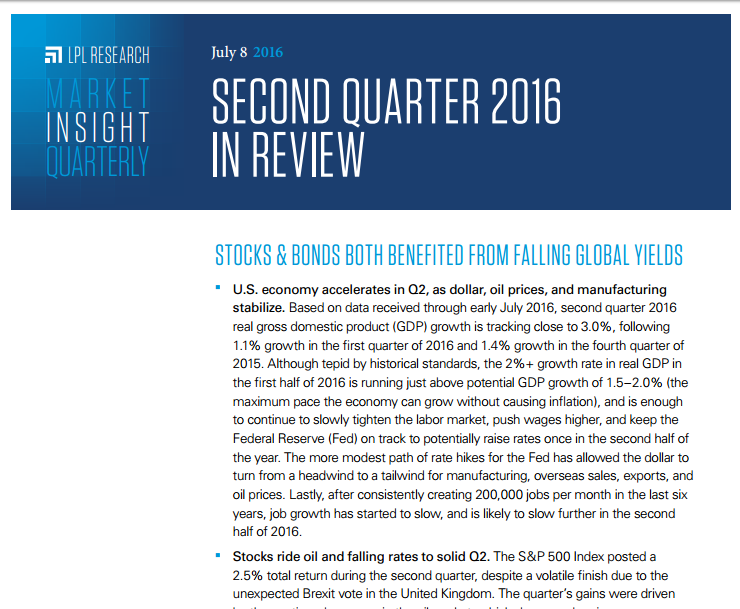STOCKS & BONDS BOTH BENEFITED FROM FALLING GLOBAL YIELDS
- U.S. economy accelerates in Q2, as dollar, oil prices, and manufacturing stabilize. Based on data received through early July 2016, second quarter 2016 real gross domestic product (GDP) growth is tracking close to 3.0%, following 1.1% growth in the first quarter of 2016 and 1.4% growth in the fourth quarter of 2015. Although tepid by historical standards, the 2%+ growth rate in real GDP in the first half of 2016 is running just above potential GDP growth of 1.5–2.0% (the maximum pace the economy can grow without causing inflation), and is enough to continue to slowly tighten the labor market, push wages higher, and keep the Federal Reserve (Fed) on track to potentially raise rates once in the second half of the year. The more modest path of rate hikes for the Fed has allowed the dollar to turn from a headwind to a tailwind for manufacturing, overseas sales, exports, and oil prices. Lastly, after consistently creating 200,000 jobs per month in the last six years, job growth has started to slow, and is likely to slow further in the second half of 2016.
- Stocks ride oil and falling rates to solid Q2. The S&P 500 Index posted a 2.5% total return during the second quarter, despite a volatile finish due to the unexpected Brexit vote in the United Kingdom. The quarter’s gains were driven by the continued recovery in the oil market, which drove crude prices more than 25% higher and propelled energy to the top of the S&P sector rankings. The pushout of Fed rate hike expectations also helped, with the resulting drop in interest rates driving gains in defensive, high-dividend-paying sectors, including consumer staples, telecom, and utilities. Despite the weak growth signal from the bond market and the soft May jobs report,
U.S. economic data were generally supportive of a pickup in economic and earnings growth, which also helped buoy investor sentiment. - Bonds have another strong quarter as global yields decline. Fixed income markets strengthened further during the second quarter. The surprise outcome of the Brexit vote, in addition to dovish central bank actions across the globe, led to broad bond strength over the quarter, with the 10- and 30-year Treasury yields falling 0.30% and 0.33%, respectively. The Barclays Aggregate Bond Index returned 2.2% for the quarter. The higher interest rate sensitivity of longer-dated fixed income was a tailwind amid the overall decline in rates. Economically sensitive, lower-credit quality sectors rallied, with high-yield returning 5.5% (Barclays U.S. Corporate High Yield Index) and bank loans 3.1% (Barclays U.S. High Yield Loan Index). International fixed income also had a strong quarter: emerging markets debt returned 5.4% (JP Morgan Emerging Markets Bond Index), currencyhedged foreign 3.1% (Citigroup Non-U.S. World Government Bond Index), and unhedged foreign 4.0% (Citigroup Non-U.S. World Government Bond Index Hedged for Currency).
- U.S. oil production declines hastened in the second quarter, driving prices higher. WTI crude oil rose 31.4% in the quarter as oil production in the U.S. fell below the 9 million barrels per day mark and ended below 8.7 million. The Bloomberg Commodity Index returned 12.8%, led by energy and precious metals. Gold and silver gained 7.9% and 23.8%, respectively, as lower interest rates and market volatility benefited the precious metals. The U.S. Dollar Index was modestly positive, increasing 1.4% in the quarter.
- Distressed debt strategies led second quarter alternative investment category returns, as the rally in oil prices supported gains in the energy and material sectors. For the quarter, the HFRX Distressed Strategies Index gained 9.02%. As measured by the -1.0% return in the HFRX Equity Hedge Index, long/short equity strategies struggled during the quarter, even as they generally continued to reduce both long and short exposure due to market volatility. A general portfolio overweight to more growth and cyclical holdings acted as a headwind, as more defensive sectors were among the top quarterly performers.

